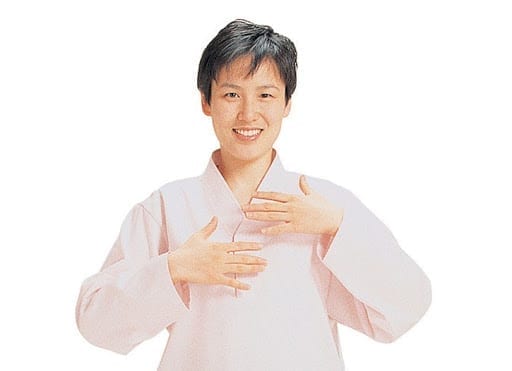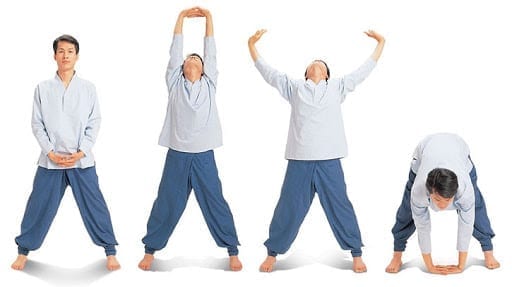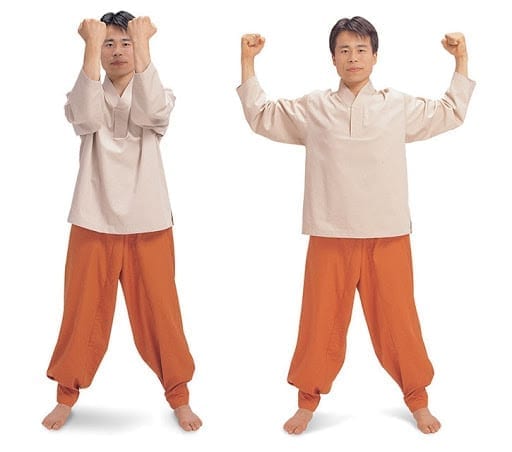We all know how important it is to breathe deeply. Taking deep, easy breaths from the abdomen can calm our mind and emotions and help circulate more oxygen throughout our body. But, often, our upper body is too tense for us to do this easily or comfortably. I’d like to introduce you to a few exercises you can use whenever your breathing feels tight or shallow.
You can find many of these exercises and more in my book, Meridian Exercise for Self-Healing.
Chest Tapping

The easiest way to loosen your chest is by tapping it. Chest Tapping can be done in any posture and you don’t need to be flexible or physically fit to do it. If you cannot tap your chest yourself, someone else can do it for you.
- Use your palms or cupped hands to tap freely over your chest and the sides of your torso.
- Keep your mouth slightly open as you tap and exhale through your mouth. Rather than deliberately forcing your breath out, breathe naturally.
- Make loose fists and use the sides where your thumbs are to tap your chest more strongly.
- Then use your fingers tips to tap concentrate your tapping on your sternum in the center of your chest. Continue to exhale through your mouth.
- The longer you tap, the more open your chest will become. Try five minutes to start and increase the amount of time you do it if your chest still feels tight.
Clasped Hands Stretch and Bend
(p. 80)

This stretch loosens more than the chest. By involving the back, shoulders, and arms, it helps to align the upper body properly to enhance the function of the respiratory system.
- Stand with your feet shoulder-width apart.
- Interlock your fingers in front of your lower abdomen.
- Inhale and stretch your arms above your head with your palms facing up. Imagine your whole body gently reaching for the sky while you focus on your lower abdomen and toes.
- Unlock your fingers. Slowly and gently bend your upper body and your head backward as much as possible.
- Exhale slowly through your mouth while you bring your extended arms around back and down toward your waist, stretching your chest open as much as you can.
- Interlock your fingers at your lower abdomen again. Inhale and bend your upper body forward from your hips. Reach toward the floor as far as you cam, trying to touch it with your palms.
- Exhale and return to Step 1. Repeat the sequence three times.
Chest Opening
(p. 306)

- Stand with your feet shoulder-width apart.
- Make fists and raise your arms, bringing your elbows in front of your face at ninety-degree angles.
- Inhale. Open your arms to the sides as far as you can.
- Feel your chest expand. Hold for several seconds.
- Exhale and return to the original posture.
- Repeat 10 times in slow motion.
Moving a Jar
(p. 47)

- Stand with your legs wide apart, knees bent and feet parallel, spine straight.
- Raise your arms to chest level, bending them at the elbows and allowing your index fingers and thumbs to touch, forming a triangle with your palms down. Move your hands away from you slightly, so your arms form a circle. Imagine you are holding a jar in between your fingers.
- Inhale and, concentrating on your spine, move your arms and upper torso to the left, holding the jar in front of your chest, allowing your head and eyes to follow.
- Pause when you’ve turned as far as you can.
- Exhale while returning to the center.
- Repeat Step 2 to the right.
- Exhale while returning to the center.
- Repeat twice.
You can do any of these exercises on their own or combine them as needed. The way to determine which exercises are best for you involves the important skill of “feeling your body.” Try each one while staying focused on how you feel and see which ones make you feel the best. Trust your body, and you’ll find what you need.
Combining chest exercises with tapping or pressing around the abdomen, especially on the Joongwan and navel acupressure points, will help you breathe even deeper. Relaxing the area below the diaphragm in this way lets the diaphragm move further into the abdomen, pulling more air further into the lungs. You can learn more about these techniques, Get Bright Breathing and Belly Button Healing respectively, from older blog posts.

2 Comments. Leave new
Very useful information during panademic. Thank you….
U I am trained in yoga and sculpting.Breathing deeply is so important for good mental health. We need to get rid of stress in our daily life.